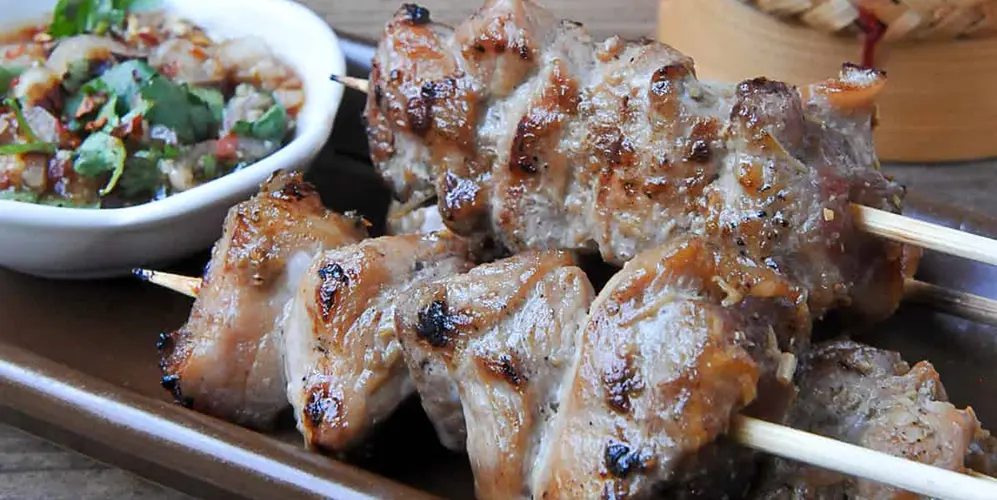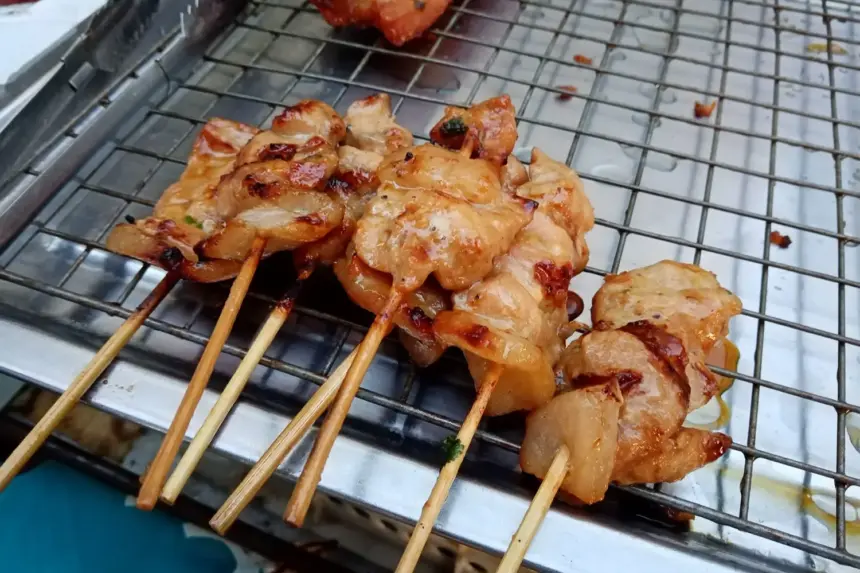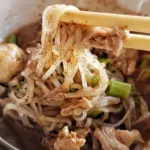Thai Food: Moo Ping (หมูปิ้ง)
When it comes to Thai street food, Moo Ping (หมูปิ้ง) is a beloved staple that you’ll find sizzling on grills across the country. These marinated, skewered, and grilled pork slices are cherished for their savory and slightly sweet flavor, as well as their tender and juicy texture. Often enjoyed as a quick snack or a filling meal, Moo Ping holds a special place in Thai culinary culture, being affordable, easily accessible, and deliciously satisfying. Whether you’re wandering through bustling markets or grabbing a quick bite on the way to work, Moo Ping is a delightful example of how Thai street food can be both simple and extraordinary.
In this article, we’ll delve into the origins of Moo Ping, its preparation methods, the key ingredients that give it its unique taste, and its cultural significance in Thailand. We’ll also explore variations of the dish and provide a guide on how you can recreate Moo Ping at home.

The Origins of Moo Ping
Moo Ping’s exact origins are hard to trace, as it’s one of those dishes that feels like it has always been a part of Thailand’s street food scene. However, it’s clear that Moo Ping embodies many aspects of Thai cuisine that have made it world-famous: a balance of flavors, the use of fresh ingredients, and a cooking method that accentuates the dish’s natural taste. It’s commonly believed that Moo Ping has roots in Thai rural communities where skewered and grilled meat has long been a popular cooking method.
The dish became particularly popular in urban areas like Bangkok in the mid-20th century, as more people moved to the city in search of work, and street food became an affordable and convenient way to enjoy a meal. Over time, Moo Ping became one of Thailand’s most beloved street foods, enjoyed by people from all walks of life.
Key Ingredients and Flavors
The ingredients that go into Moo Ping may seem simple, but they are carefully chosen to create a harmonious balance of flavors and textures. Here’s a breakdown of the main ingredients that make Moo Ping so delicious:
- Pork: The star ingredient of Moo Ping is, of course, the pork. Traditionally, pork shoulder or pork collar is used because it has the perfect amount of fat to keep the meat juicy and tender when grilled. Some variations may also use pork belly, which adds an extra layer of richness due to its higher fat content.
- Marinade: The marinade is essential to creating Moo Ping’s signature taste. It typically includes:
- Coconut Milk: Adds a subtle sweetness and creaminess, helping to tenderize the meat.
- Garlic: Provides a savory and aromatic flavor base.
- Coriander Root: A traditional Thai ingredient that adds a fresh, earthy taste.
- White Pepper: Enhances the flavors with a mild, peppery kick.
- Oyster Sauce: Contributes to the savory depth and umami flavor.
- Soy Sauce: Adds saltiness and a rich color to the pork.
- Fish Sauce: A key ingredient in Thai cooking that adds a layer of complexity.
- Palm Sugar: Balances the saltiness with a touch of sweetness.
- Bamboo Skewers: These are used to hold the marinated pork pieces together during grilling, allowing the meat to cook evenly and develop a slight char for that perfect smoky flavor.
The Preparation Process
Preparing Moo Ping is a relatively simple process, though it does require some time for marinating to allow the flavors to fully develop. Here’s a step-by-step guide on how Moo Ping is traditionally prepared:
- Marinating the Pork:
- The pork is sliced into thin pieces, usually about 1/4 inch thick. This ensures that the pork cooks quickly and absorbs the marinade fully.
- The ingredients for the marinade are mixed together, and the pork slices are coated evenly with the mixture.
- The pork is then left to marinate for at least 2–4 hours, though many Thai cooks recommend leaving it overnight for maximum flavor absorption.
- Skewering the Pork:
- Once the pork has marinated, it’s time to skewer it. The bamboo skewers are soaked in water beforehand to prevent them from burning on the grill.
- The pork slices are threaded onto the skewers, with each skewer holding around 3–4 pieces, depending on the size.
- Grilling the Pork:
- Moo Ping is typically grilled over a charcoal fire, which imparts a smoky flavor that is characteristic of Thai street food. The skewers are placed on the grill and turned occasionally to ensure even cooking.
- As the pork grills, the marinade caramelizes, creating a delicious crust that enhances the flavor.
- The skewers are brushed with additional marinade or coconut milk during grilling to keep them moist and enhance the flavor.
Serving Moo Ping
Moo Ping is usually served hot off the grill, often accompanied by sticky rice (Khao Niew). The combination of the savory, slightly sweet pork with the chewy and slightly salty sticky rice is a match made in heaven. You might also find Moo Ping served with a side of Nam Jim Jeaw, a spicy dipping sauce made from chili, lime juice, fish sauce, and toasted rice powder, which adds an extra layer of flavor.
Variations of Moo Ping
While the traditional Moo Ping recipe is beloved for its simplicity, there are several variations that offer new twists on this classic dish:
- Moo Ping Krob (Crispy Moo Ping):
- This version uses a crispier cut of pork, like pork belly, and is cooked until the edges are crispy and golden. It has a richer flavor due to the extra fat content, which creates a satisfying crunch.
- Spicy Moo Ping:
- For those who enjoy a bit of heat, Spicy Moo Ping incorporates fresh chili peppers or chili paste into the marinade. This adds a kick to the traditional recipe, making it a favorite for spice lovers.
- Moo Ping with Herbs:
- Some variations include additional herbs like lemongrass, kaffir lime leaves, or Thai basil in the marinade, which infuse the pork with aromatic flavors and create a more complex taste profile.
- Moo Ping with Tamarind Sauce:
- Tamarind sauce can be added to the marinade or served as a dipping sauce, giving the dish a tangy and slightly sour note that complements the sweet and savory flavors.
Cultural Significance and Popularity
Moo Ping is more than just a snack; it’s an integral part of Thai culture and everyday life. It’s particularly popular for breakfast, as street vendors start grilling the skewers early in the morning, filling the air with the mouth-watering aroma of charred pork. Office workers, students, and locals alike grab a few skewers of Moo Ping to enjoy on their commute, making it a quintessential breakfast choice.
The dish is also a reflection of Thailand’s social and cultural atmosphere, where street food plays a central role in daily life. Eating Moo Ping on the go, at a food stall, or by the roadside is an experience that connects people from all backgrounds, providing a shared moment of culinary pleasure.
How to Make Moo Ping at Home
While the best Moo Ping is often found on the streets of Thailand, it’s surprisingly easy to make at home with a few simple ingredients and a grill. Here’s a quick recipe to help you recreate Moo Ping:
Ingredients:
- 1 pound pork shoulder or pork collar, thinly sliced
- 1/4 cup coconut milk
- 3 cloves garlic, minced
- 1 tablespoon coriander root, minced
- 1 teaspoon white pepper
- 2 tablespoons oyster sauce
- 2 tablespoons soy sauce
- 1 tablespoon fish sauce
- 2 tablespoons palm sugar
- Bamboo skewers, soaked in water
Instructions:
- In a bowl, mix coconut milk, garlic, coriander root, white pepper, oyster sauce, soy sauce, fish sauce, and palm sugar until well combined.
- Add the pork slices to the marinade, ensuring each piece is coated evenly. Cover and marinate in the refrigerator for at least 2 hours or overnight.
- Preheat a charcoal grill or gas grill to medium heat.
- Thread the marinated pork onto the soaked bamboo skewers.
- Grill the skewers for about 10–15 minutes, turning occasionally, until the pork is cooked through and has a nice char.
- Serve hot with sticky rice and, if desired, Nam Jim Jeaw for dipping.
Conclusion
Moo Ping is a beloved Thai dish that exemplifies the best of Thai street food culture. Its simple ingredients and easy preparation make it accessible, yet its depth of flavor is a testament to the skill and care that goes into Thai cooking. Whether enjoyed on the streets of Bangkok or recreated at home, Moo Ping is sure to satisfy with its mouth-watering combination of savory, sweet, and smoky flavors. For anyone looking to experience authentic Thai cuisine, Moo Ping is a must-try dish that will leave a lasting impression.










